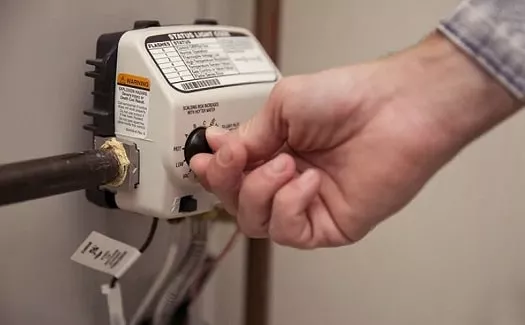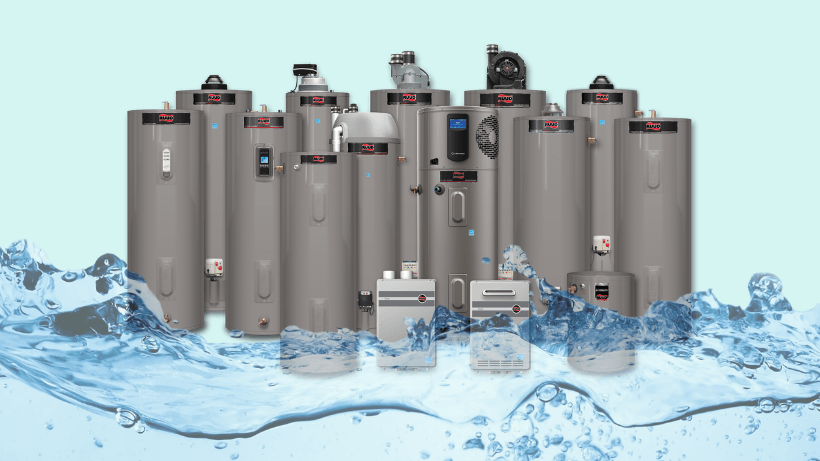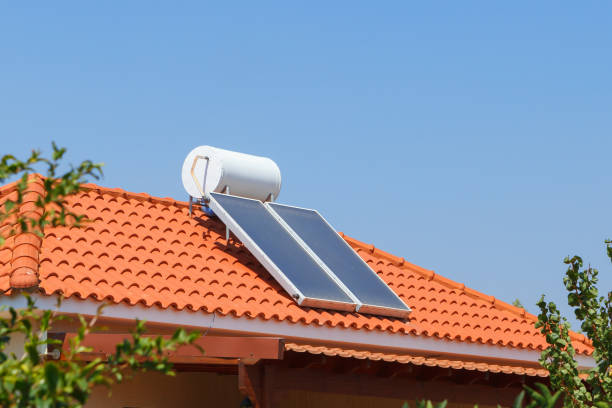Introduction:

Hello there! We all know how crucial hot water is in our daily lives, whether it’s for a comforting shower, washing dishes, or doing laundry. It’s one of those things we often take for granted until it’s not working correctly. So, let’s dive into the world of water heaters and explore how to troubleshoot when your hot water is only warm.
Brief Overview of the Importance of Hot Water Heaters in Daily Life:
Hot water heaters play a pivotal role in our routines, providing the convenience of instant hot water for various household needs. They ensure a steady supply of heated water, making our lives comfortable and our chores manageable.
I. Understanding Your Water Heater:

Understanding your water heater is the first step in troubleshooting. Water heaters come in different types, each with its unique characteristics and methods of heating water.
A. Types of Water Heaters:

Gas Water Heaters:
These heaters use a gas burner under the tank to heat the water. They typically have a pilot light and a gas valve to control the flame.
Electric Water Heaters:
Electric water heaters use heating elements inside the tank to heat the water, controlled by a thermostat to maintain the desired temperature.
Tankless Water Heaters:
Tankless, or on-demand water heaters, heat water directly without the use of a storage tank, providing hot water only as it is needed.
Solar Water Heaters:

Solar water heaters use energy from the sun to heat water, making them an eco-friendly option.
II. Troubleshooting Warm Water Issues:

When your hot water is only warm, it could be due to several reasons such as a faulty thermostat, sediment buildup, or issues with the heating element. Here’s a step-by-step guide to help you identify and resolve the issue:
A. Check the Thermostat:
Ensure that the thermostat is set to the desired temperature. If it’s set correctly but the water is still not hot enough, the thermostat might be faulty and may need replacement.
B. Inspect the Heating Element:
For electric water heaters, a malfunctioning heating element could be the culprit. Check for any signs of damage or corrosion and consider replacing it if necessary.
C. Examine the Gas Valve and Pilot Light:
For gas water heaters, ensure that the gas valve is open and the pilot light is lit. If the pilot light keeps going out, there might be an issue with the thermocouple.
D. Look for Sediment Buildup:
Over time, sediment can accumulate at the bottom of the tank, affecting the water heater’s efficiency. Flushing the tank regularly can prevent this issue.
E. Assess Water Pressure and Flow Rate:
Low water pressure or flow rate can affect the water’s temperature. Check the water line and faucet for any blockages or leaks and repair them as needed.
F. Investigate for Mineral Buildup and Corrosion:
Hard water can lead to mineral buildup, and corrosion can occur due to the constant contact with water. Inspect the tank and pipes for any signs of corrosion or mineral deposits and clean or replace the affected parts.
III. Maintenance and Safety:
Regular maintenance can prolong the life of your water heater and ensure its optimal performance. Always prioritize safety, especially when dealing with gas water heaters, to prevent carbon monoxide poisoning.
A. Regular Inspections and Maintenance:
Conduct regular inspections for any signs of leaks, corrosion, or sediment buildup and address them promptly. Regular maintenance includes flushing the tank and checking the pressure relief valve.
B. Safety Measures:
Install carbon monoxide detectors near gas water heaters and ensure proper ventilation to prevent any hazards.
B. Safety Precautions:
Safety is paramount when dealing with water heaters. It’s crucial to read and follow the safety instructions located on the water heater to prevent any accidents or damage. Whether you have a gas or electric water heater, adhering to safety precautions ensures your well-being and that of your household.
Importance of Reading and Following Safety Instructions Located on the Water Heater:
The safety instructions provided on the water heater are there to guide you on proper usage and maintenance. They contain vital information on the operational limits of the water heater, precautions to avoid accidents, and steps to take in case of an emergency. Ignoring these instructions can lead to serious consequences such as fires, explosions, or carbon monoxide poisoning.
Ensuring the Gas is Turned Off Before Starting Up Your Gas Water Heater:
For those with gas water heaters, it’s imperative to ensure that the gas valve is turned off before starting any work on the unit. This prevents any gas leaks which can be hazardous. A gas leak can lead to fire or explosion if it comes into contact with a flame or spark. Always check for the smell of gas around the water heater; if you detect a gas smell, immediately turn off the gas supply and ventilate the area.
V. Practical Solutions and Repairs:
When your hot water is only warm, practical and effective solutions are needed to restore it to the desired temperature. Here’s a detailed guide on how to approach various issues:
A. Adjusting the Thermostat:

Sometimes, the solution can be as simple as adjusting the thermostat to a higher setting. Ensure that it’s set to the recommended temperature, usually between 120°F and 140°F, to avoid scalding.
B. Flushing the Tank:
Sediment buildup can affect the efficiency of the water heater. Regularly flushing the tank can help in removing the sediment and improving the water heater’s performance.
C. Inspecting and Replacing the Heating Element:
A faulty heating element can cause the water to be lukewarm. Inspect the heating element for any signs of damage or corrosion and replace it if necessary.
D. Checking the Water Pressure and Flow Rate:
Low water pressure and flow rate can also affect the temperature of the water. Inspect the water line and faucets for any blockages and repair them to restore proper water flow.
E. Plumbing Repair:
If you suspect that the issue is related to the plumbing, it’s best to consult a professional plumber for a thorough inspection and necessary repairs.
II. Activating Gas Water Heaters:
Gas water heaters are a common choice for many households due to their efficiency and reliability. However, they do require some knowledge and care when activating to ensure safe and optimal operation.
A. Locating and Using the Gas Valve:

The gas valve is a crucial component of your gas water heater, controlling the flow of gas to the burner.
Description of the Gas Valve Location and its Functionality:
The gas valve is typically located at the bottom of the water heater. It serves as the gateway for gas to enter the burner, where it is ignited to heat the water. It’s essential to know its location and functionality to safely operate the water heater.
Steps to Safely Turn on the Gas Valve:
- Ensure the water heater is filled with water.
- Locate the gas valve and turn it to the “off” position.
- Wait for a few minutes to allow any residual gas to dissipate.
- Turn the gas valve to the “pilot” position and press down on it.
- While holding the valve down, light the pilot light.
- Once the pilot light is stable, turn the gas valve to the “on” position.
B. Lighting the Pilot Light:
The pilot light is a small flame that ignites the main burner in your gas water heater.
Explanation of the Pilot Light and its Role in Gas Water Heaters:
The pilot light serves as the ignition source for the main burner. It’s crucial for the operation of gas water heaters, ensuring that the burner can ignite safely and efficiently whenever hot water is needed.
Detailed Steps on How to Light the Pilot Light Manually or Using an Electronic Autoignition Feature:
- Locate the pilot light assembly, usually found beneath the gas valve.
- If your water heater has an electronic ignition, simply press the ignition button.
- For manual lighting, use a long lighter or match to ignite the pilot light while pressing down on the gas valve.
- Once the pilot light is stable, release the gas valve and ensure the flame remains lit.
C. Setting the Temperature:
Adjusting the thermostat to the right temperature is crucial to avoid scalding and to ensure energy efficiency.
Guidance on Adjusting the Thermostat to the Desired Temperature Setting:
The thermostat is usually located behind an access panel on the water heater. Adjust it to the desired temperature, keeping in mind that the recommended setting is between 120°F and 140°F to prevent scalding and save energy.
Mention of the Recommended Temperature to Avoid the Risk of Scalding:
Setting the thermostat above 140°F increases the risk of scalding and is generally not recommended. A lower setting also helps in reducing the energy bill and extending the lifespan of the water heater.
III. Turning On Electric Water Heaters:
Electric water heaters are known for their efficiency and ease of use. However, turning them on involves specific steps to ensure safety and optimal functioning.
A. Locating the Circuit Breaker:
The circuit breaker is essential for controlling the power supply to your electric water heater.
Steps to Find and Turn on the Circuit Breaker Controlling the Water Heater:
- Locate your home’s electrical panel, usually found in the basement, garage, or a utility closet.
- Identify the circuit breaker labeled for the water heater.
- Ensure the water tank is full before flipping the breaker to the “on” position to avoid damage to the heating element.
Importance of Ensuring the Water Tank is Full Before Turning on the Breaker:
Turning on the power when the tank is empty can burn out the heating element. Always fill the tank with water first to avoid any damage to the water heater and ensure its longevity.
B. Setting the Temperature:
Once the power is on, adjusting the thermostat to the right temperature is crucial for comfort and safety.
Instructions on Adjusting the Thermostat to the Desired Temperature:
The thermostat is usually located behind a panel on the side of the water heater. Use a screwdriver to remove the panel, adjust the thermostat to the desired temperature, and replace the panel securely. The recommended temperature setting is between 120°F and 140°F to prevent scalding and ensure energy efficiency.
Reminder of the Recommended Temperature Setting:
Maintaining the temperature within the recommended range not only prevents the risk of burns but also helps in reducing energy consumption and the water bill. A lower setting is also beneficial in slowing down the buildup of scale and prolonging the life of the water heater.
IV. Operating Tankless Water Heaters:
Tankless water heaters, also known as on-demand or instantaneous water heaters, provide hot water only as it is needed. They don’t produce the standby energy losses associated with storage water heaters, which can save you money. Here’s how to operate them effectively:
A. Using the Breaker or Switch:
Tankless water heaters are typically turned on using a breaker or a switch, depending on whether they are electric or gas models.
Explanation of How to Turn on Tankless Water Heaters Using the Corresponding Breaker or Switch:
Locate the breaker or switch corresponding to the water heater.
Ensure the water heater is connected to the water supply.
If it’s a gas model, make sure the gas is turned off before flipping the switch or breaker to the “on” position.
Once the water heater is on, it will start heating water as it flows through the unit.
Importance of Ensuring the Gas is Turned Off Before Starting Up a Tankless Gas Water Heater:
For gas models, it’s crucial to ensure the gas is turned off before starting the water heater to avoid any risk of gas leaks or explosions. Always follow the manufacturer’s instructions and safety precautions when operating gas appliances.
B. Adjusting the Temperature Controller:
Most tankless water heaters come with a digital temperature controller allowing you to set the desired temperature for your hot water.
Guidance on Using the Temperature Controller, Often Digital, to Set the Desired Temperature:
Locate the temperature controller, usually found on the front of the unit.
Use the buttons or dial to set the desired temperature.
Monitor the display to confirm the set temperature.
Adjust as needed to reach the preferred hot water temperature, keeping in mind the recommended range of 120°F to 140°F to prevent scalding.
Brief Mention of the On-Demand Operation of Tankless Water Heaters:
Tankless water heaters operate on-demand, heating water instantly as it flows through the unit, eliminating the need for a storage tank and reducing energy consumption and the water bill.
V. Troubleshooting Common Issues:
When dealing with water heaters, encountering issues is inevitable. Here’s how to troubleshoot some common problems effectively:
A. Addressing Pilot Light Problems:
The pilot light is a small flame that is crucial for the operation of gas water heaters, and it can sometimes go out or fail to stay on.
Solutions for Situations Where the Pilot Light is Not Staying On:
- Ensure the gas valve is turned on.
- Check if there is a gas supply.
- If the pilot light goes out repeatedly, there might be a problem with the thermocouple or the gas supply.
- Clean the pilot light orifice if the flame is yellow or orange.
- If the pilot light still doesn’t stay on, it might be time to call a professional for Plumbing Repair.
Importance of Holding the Pilot Button Long Enough for the Thermocouple to Heat Up:
The thermocouple needs to detect the flame, and for this to happen, you must hold down the pilot button long enough. If released too soon, the pilot light will go out, and the water heater will not function.
B. Dealing with Water Heating Delays:
Different water heaters have varying heating times, and understanding this can help manage expectations and identify when there is a real issue.
Explanation of the Typical Heating Times for Different Water Heater Types:
• Tank Water Heaters:
• These typically take about 30 minutes to an hour to heat the water to the desired temperature.
• Tankless Water Heaters:
• These heat water on demand and typically deliver hot water in a few seconds to minutes, depending on the flow rate and incoming water temperature.
• Heat Pump Water Heaters:
• These can take longer, usually about 1 to 2 hours, due to their different heating mechanism.
Suggestions for What to Do if the Water is Not Heating Up as Expected:
- Check the thermostat setting and adjust it if necessary.
- Inspect the heating element or burner for any issues.
- Check for tripped breakers or closed gas valves.
- If the water still doesn’t heat up as expected, consider seeking professional help.
VI. Conclusion:
In this guide, we’ve traversed the realms of various water heaters, delving into the intricacies of their operation, troubleshooting, and safety precautions.
Recapitulation of the Key Steps to Turn on Different Types of Water Heaters:
Whether it’s the conventional gas and electric water heaters with their respective pilot lights and circuit breakers or the modern tankless variants with their on-demand heating, understanding the nuances of each is crucial. Remember to locate the correct switches, valves, and controls, and to ensure the water tank is full before powering on to avoid damage to the heating element.
Emphasis on the Importance of Following Safety Instructions and Setting Appropriate Temperatures:
Adherence to safety instructions is paramount. The thermostat should be set between 120°F and 140°F to avoid scalding and to optimize energy efficiency. Regular maintenance and adherence to safety protocols can prevent accidents and prolong the life of your water heater.
FAQ:
How do you light an electric water heater?
Electric water heaters do not have a pilot light. They are powered by electricity, and you can turn them on by flipping the corresponding circuit breaker to the “on” position after ensuring the tank is full of water.
How do I reset my hot water heater?
To reset your hot water heater, locate the reset button, usually found on the thermostat, and press it. If the water heater doesn’t respond, check the circuit breaker and reset it if it’s tripped. For gas models, ensure the pilot light is on. If the issue persists, consult a professional for Leak Detection and Repair.
How long do you have to wait for hot water to come back?
The waiting time for hot water depends on the type of water heater. Tank water heaters typically take about 30 minutes to an hour, tankless water heaters provide hot water on demand, and heat pump water heaters can take 1 to 2 hours.
Can I turn on the water heater if the tank is not full?
No, turning on the water heater when the tank is not full can damage the heating element in electric models and can be a safety hazard in gas models. Always ensure the tank is full before turning on the water heater.
What should I do if I smell gas around my gas water heater?
If you smell gas, immediately turn off the gas supply, open windows and doors to ventilate the area, and evacuate the premises. Do not turn on lights or use electronic devices as they can ignite the gas. Once you are in a safe location, call your gas company or a professional plumber to address the issue.

